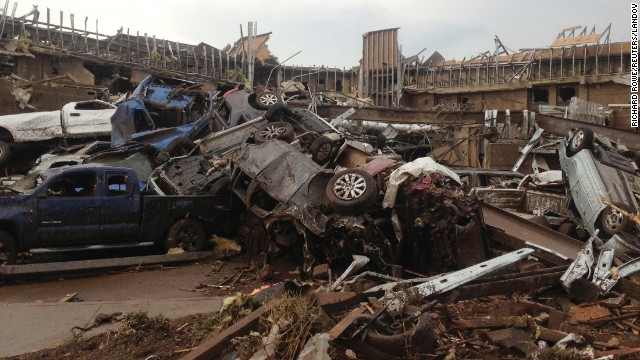Long viewed as one of the most, if not the most, polluted places in the United States, cleanup at the Hanford, WA, nuclear site has slowed to a crawl. I remember first reading about Hanford during high school via a Scientific American article. Government beaurocracy and waste are once again on display.
Hanford Site article (Wikipedia) - https://en.wikipedia.org/wiki/Hanford_Site
Continue on the the lengthy eye-popping article below (
article from SCIENTIFIC AMERICAN online).
Hanford Nuclear Waste Cleanup Plant May Be Too Dangerous
Safety issues make plans to clean up a mess left over from the construction of the U.S. nuclear arsenal uncertain
VIT PLANT: Even as the new facility to deal with the radioactive legacy of the Hanford Site is built, some critics have questioned its ability to handle the cleanup.Image: Courtesy of Bechtel
More In This Article
 Photo Album
Photo Album
The most toxic and voluminous
nuclear waste in the U.S.—208 million liters —sits in decaying underground tanks at the Hanford Site (a nuclear reservation) in southeastern Washington State. It accumulated there from the middle of World War II, when the Manhattan Project invented the first nuclear weapon, to 1987, when the last reactor shut down. The federal government’s current attempt at a permanent solution for safely storing that waste for centuries—the Waste Treatment and Immobilization Plant here—has hit a major snag in the form of potential chain reactions, hydrogen explosions and leaks from metal corrosion. And the revelation last February that six more of the storage tanks are currently leaking has further ramped up the pressure for resolution.
After decades of research, experimentation and political inertia, the U.S. Department of Energy (DoE) started building the “
Vit Plant” at Hanford in 2000. It’s intended to sequester the waste in stainless steel–encased glass logs, a process known as vitrification (hence “Vit”), so it cannot escape into the environment, barring
natural disasters like earthquakes or catastrophic fires. But progress on the plant slowed to a crawl last August, when numerous interested parties acknowledged that the plant’s design might present serious safety risks. In response, then-Energy Secretary Steven Chu appointed an expert panel to find a way forward. Because 60 of the 177 underground tanks have already leaked and all are at increasing risk to do so, solving the problem is urgent.
Vitrification prep 101: Some tough homework The plant’s construction, currently contracted by the DoE to Bechtel National, Inc., may be the most complicated engineering project underway in the U.S. But back in 2000 the DoE and Bechtel decided to save time and money by starting construction before crucial structures and processes had been designed and properly tested at a scale comparable to full operation. This wasn’t such a good idea, says Dirk Dunning, nuclear material specialist with the Oregon Department of Energy. “The worst possible time to save money is at the beginning. You’re better off to be very nearly complete on design before you begin construction.”
The vitrification project calls for the waste to be analyzed chemically and radiologically before it enters a pretreatment facility to be separated into various constituents such as cesium 137, strontium 90 and metals. After that, each separate waste stream is channeled as either high-level or low-activity waste into designated melters. The glass is created by mixing sand with a few additives like boron; the waste is stirred in, and the whole mess is melted, then decanted into the steel canisters. After the glass logs solidify the waste is trapped and should be isolated from the environment for long enough for most of the radioactivity to decay to safe levels.
The low-level waste canisters will be stored permanently at Hanford. Because the planned Yucca Mountain geologic repository project was halted by the Obama administration, the high-level waste canisters will be kept at Hanford in an as-yet unconstructed building. In January the DoE announced it is beginning work on a new “comprehensive management and disposal system” that will make a permanent geologic repository available by 2048. Yet even if all goes perfectly from now on, it will take until 2062 to vitrify all the waste.
The waste presents significant challenges for Vit Plant project engineers and nuclear chemists. For one thing, the waste varies wildly from tank to tank. The former nuclear weapons facility at Savannah River, Ga.—also part of the Manhattan Project—has been successfully vitrifying weapons waste for years, but only one fuel separation process was used there. At Hanford there were nine production reactors making plutonium and uranium fuel using at least six different radiochemical processes whose chemistry, and thus constituents, were very different. This remains true of the waste as well. There are large differences in composition from tank to tank that necessitate chemically profiling the waste in batches before it enters the Vit Plant, which may also require changes to the glass formula at the other end of the process.
Overall, the tanks hold every element in the periodic table, including half a ton of plutonium, various uranium isotopes and at least 44 other radionuclides—containing a total of about 176 million curies of radioactivity. This is almost twice the radioactivity released at Chernobyl, according to
Plutopia: Nuclear Families, Atomic Cities, and the Great Soviet and American Plutonium Disasters, by Kate Brown, a history professor at the University of Maryland, Baltimore County. The waste is also physically hot as well as laced with numerous toxic and corrosive chemicals and heavy metals that threaten the integrity of the pipes and tanks carrying the waste, risking leakage.
The physical form of the waste causes problems, too. It’s very difficult to get a representative sample from any given tank because the waste has settled into layers, starting with a baked-on “hard heal” at the bottom, a layer of salt cake above that, a layer of gooey sludge, then fluid, and finally gases in the headspace between the fluid and the ceiling. Most of the radioactivity is in the solids and sludge whereas most of the volume is in the liquids and the salt cake.
Going with the flow All of these considerations contribute to the overall problem, which can be summed up in one word: flow. To get to the glass log stage the waste has to travel through an immense labyrinth of tanks and pipes. It has to move at a fast enough clip to avoid pipe and filter clogs as well as prevent solids from settling. This is quite a challenge given the multiphasic nature of the waste: solids, liquids, sludge and gases all move differently. The waste feed through the system will be in the form of a “non-Newtonian slurry”—a mixture of fluids and solids of many different shapes, sizes and densities. If the solids stop moving, problems ensue.
For one thing, there’s a chance that enough plutonium could congregate to trigger a nuclear chain reaction, or criticality—the self-sustaining cascade of atomic fission that releases massive amounts of energy. That would be a serious event even if an explosion did not breach the concrete containment building. Hot slurry could surge backward through the piping, spreading the problem to other parts of the system. Waste solids could also clog pipes, along with ion-exchange filters designed to grab the most radioactive constituents from the low-level waste for addition to the high-level stream.
Whether the solids pile up in the vessels, the pipes or the filters, says Donna Busche, nuclear and environmental safety manager for Hanford contractor URS Corp., “that’s where I’ve got the problem.” Further construction of the Vit Plant’s flawed components cannot proceed unless Busche issues an operating permit, which she is loath to do. She calls the DoE’s failure to require that Bechtel resolve the safety issues sooner “obscene.”
A second explosive risk could arise because both heat and radiation can disassemble
water into oxygen and hydrogen. If there are not places along the piping and in the vessels for hydrogen to exit the flow of waste, enough could build up to explode.
And then there’s the extreme radioactivity of the waste, which is far too high for direct human exposure. Enter the Vit Plant’s notorious “black cells.” These are 18 massive concrete enclosures populated by smaller stainless steel vessels. The idea is to guide the waste through the vessels without any human intervention over the 40 years officials believe it will take to process all the waste. The only way to do this is to ensure that the black cells have no moving parts. But because the waste has to be constantly stirred to prevent settling of the noxious and radioactive solids, the plan calls for pulse jet mixers—described as “turkey basters”—to keep the solids suspended.
The pulse jet mixers suck waste into their vertical tubes and then eject it forcefully back into the tanks. Unfortunately, they have not yet been shown to provide sufficient mixing at the scale necessary for the Vit Plant. They do, however, apply enough force to the slurry for the solids to grind away at the stainless steel of tanks and pipes, weakening them enough to risk leakage. Besides this erosion, there’s also potential for chemical corrosion. The Defense Nuclear Safety Board, which advises the White House, has called these problems “a show-stopper.”
“The way [the plant] is currently designed poses unacceptable risks. DoE now admits that,” says Tom Carpenter, executive director of the watchdog group Hanford Challenge. In December the Government Accountability Office issued a highly
critical analysis of the Vit Plant’s unresolved safety issues
Disagreements over the safety risks have also prompted outspoken protests from several senior Hanford officials. Chief project engineer Gary Brunson resigned in January. Busche and former deputy chief process engineer Walter Tamosaitis filed whistleblower complaints alleging that their concerns about safety were suppressed by Bechtel. (Bechtel declined to be interviewed for this story, citing nondisclosure agreements signed with Chu’s expert panel.)
But Langdon Holton, DoE’s senior technical authority for the Vit Plant and a member of Chu’s expert panel, believes the project’s problems are technical snags, rather than the insoluble consequence of incompetence or hubris. He also thinks that although the current risks are real, they are unlikely and would be of low magnitude if they did occur. For example, he says, “You’d have to have a vessel unmixed for half a year” for enough hydrogen to accumulate for a significant explosion. “Do I have concern we won’t be able to resolve the issues? No, but it will take some time,” he adds. (Chu’s panel does not expect to issue a formal report, according to Holton.)
Time may be limited. The 177 tanks, built between 1943 and 1986 and most intended for only about a 20-year life span, are decaying; at last count, six are leaking. The Vit Plant was supposed to start operating in 2007 and is now projected to begin in 2022. Its original budget was $4.3 billion and is now estimated at $13.4 billion. Nobody is suggesting the project be abandoned, yet forging ahead without confidence in the plant’s safe operation is not really an option either. The real question, many Hanford watchers say, is whether the country wants to pay for doing it right.
Busche is adamant that the safety issues must be solved before plans proceed further. “The level of robustness we have to put in all our systems is derived from the waste itself,” she says. “It’s the gift that keeps giving until it’s in a glass log.”





 Photo Album
Photo Album 

